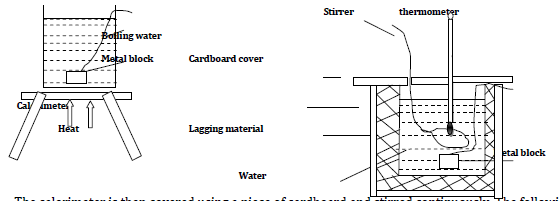a) Specific heat capacity of solids
In this method, a known mass of a solid, e.g. a metal block is heated by dipping it in a bath of hot water. After some time, the solid is very fast transferred into cold water in a calorimeter and whose mass is known.

The calorimeter is then covered using a piece of cardboard and stirred continuously. The following measurements are then recorded:
- Mass of the solid metal block, ms
- Mass of copper calorimeter with the stirrer, mc
- Mass of the calorimeter and stirrer + water, m1
- Temperature of the boiling water (initial temperature of the metal block), ?s
- Temperature of cold water in the calorimeter (initial temperature of calorimeter), ?w
- Final steady temperature of the mixture, ?
Calculation
Mass of the water in the calorimeter = m1 – mc = mw
Temperature change of the hot metal block = ?s – ?
Temperature change of the water in the calorimeter and the calorimeter = ?- ?w
Assuming there is no heat loss to the surrounding when the metal block is being transferred into the cold water and thereafter;
Amount of heat lost by the metal block = amount of heat gained by calorimeter with stirrer + amount of heat gained by water in the calorimeter.
i.e. mscs(?s-?) = mccc(?-?w) + mwcw(?-?w)
wherecs – specific heat capacity of the metal block
cc – specific heat capacity of the copper calorimeter
cw – specific heat capacity of water.
Hence specific heat capacity of the metal block, cs=[mccc(?-?w) + mwcw(?-?w)] /ms(?s-?)
b) Specific heat capacity of a liquid.
In this case, a solid of known specific heat capacity is used and the water in the calorimeter is replaced with the liquid whose specific heat capacity is to be determined. The solid metallic block is first heated in a bath of boiling water and then transferred into the calorimeter containing the liquid. The following measurements are then collected:
- Mass of the metal block, ms
- Mass of the calorimeter with stirrer, mc
- Mass of the calorimeter, stirrer and the liquid, m1
- Initial temperature of the metal block, ?s
- Initial temperature of the liquid, ?l
- Final steady temperature of the mixture, ?
If the there is no heat loss to the surrounding, then the quantity of heat lost by the metal block equals the quantity of heat gained by the calorimeter with stirrer and the liquid.
i.e. mscs(?s– ?) = [mccc(?-?l) + mlcl(?-?l)]
Hence cl = [mccs(?s – ?) - mccc(?-?l)] / ml(?-?l)
Alternatively the specific heat capacity of a liquid can be obtained by mixing it with another liquid whose specific heat capacity is known and their common temperature determined.
The following precautions must be taken to minimize heat losses to the surroundings:
- Using a highly polished calorimeter
- Heavily lag the calorimeter
- Using a lid of poor thermal conductivity
sharon kalunda answered the question on
April 24, 2019 at 09:29